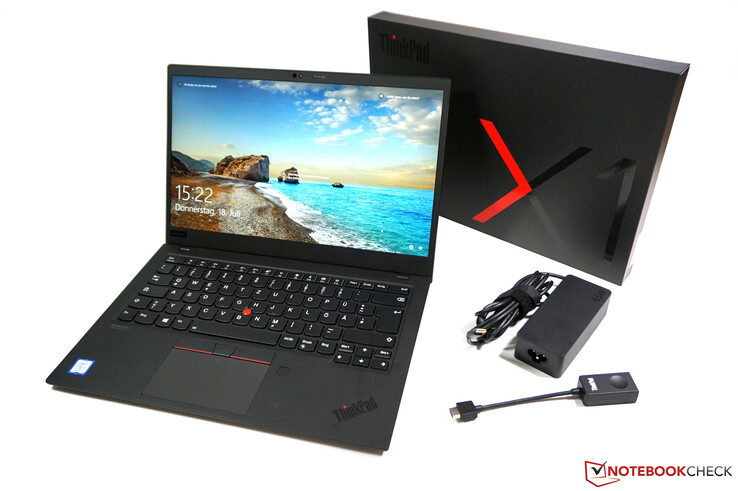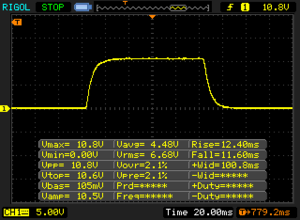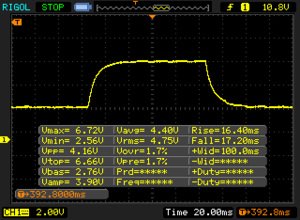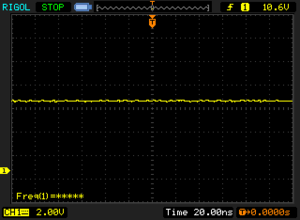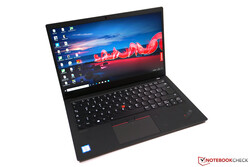Análise ao Vivo do Lenovo ThinkPad X1 Carbon 2019 WQHD: Ainda a referência entre os portáteis empresariais?
| |||||||||||||||||||||||||
iluminação: 88 %
iluminação com acumulador: 337 cd/m²
Contraste: 786:1 (Preto: 0.43 cd/m²)
ΔE ColorChecker Calman: 4 | ∀{0.5-29.43 Ø4.78}
calibrated: 1.7
ΔE Greyscale Calman: 6.2 | ∀{0.09-98 Ø5}
97.8% sRGB (Argyll 1.6.3 3D)
68.1% AdobeRGB 1998 (Argyll 1.6.3 3D)
73.8% AdobeRGB 1998 (Argyll 3D)
97.8% sRGB (Argyll 3D)
72.5% Display P3 (Argyll 3D)
Gamma: 2.13
CCT: 6787 K
Os Top 10
» Os Top 10 Portáteis Multimídia
» Os Top 10 Portáteis de Jogos
» Os Top 10 Portáteis Leves para Jogos
» Os Top 10 Portáteis Acessíveis de Escritório/Empresariais
» Os Top 10 Portáteis Premium de Escritório/Empresariais
» Os Top 10 dos Portáteis Workstation
» Os Top 10 Subportáteis
» Os Top 10 Ultrabooks
» Os Top 10 Conversíveis
» Os Top 10 Tablets
» Os Top 10 Smartphones
» A melhores Telas de Portáteis Analisadas Pela Notebookcheck
» Top 10 dos portáteis abaixo dos 500 Euros da Notebookcheck
» Top 10 dos Portáteis abaixo dos 300 Euros
| Lenovo ThinkPad X1 Carbon 2019-20QE000VGE LP140QH2-SPD1, , 2560x1440, 14" | Lenovo ThinkPad X1 Carbon 2018-20KGS5DU00 LP140QH2-SPB1, , 2560x1440, 14" | Lenovo ThinkPad X1 Carbon G6-20KG0025UK Lenovo LEN40A9 / AUO B140HAK02.3, , 1920x1080, 14" | Lenovo ThinkPad X1 Carbon 2018-20KGS03900 B140QAN02.0, , 2560x1440, 14" | Lenovo ThinkPad T490s-20NYS02A00 B140HAN05.7, , 1920x1080, 14" | HP Elitebook x360 1040 G5 AU Optronics AUO533D, , 1920x1080, 14" | Dell Latitude 7490 AUO503D (D04YD_B140HAN), , 1920x1080, 14" | |
|---|---|---|---|---|---|---|---|
| Display | 0% | -5% | 19% | -5% | -9% | -6% | |
| Display P3 Coverage (%) | 72.5 | 72.7 0% | 68.3 -6% | 87.7 21% | 67.1 -7% | 64.3 -11% | 66.6 -8% |
| sRGB Coverage (%) | 97.8 | 97.9 0% | 94.9 -3% | 100 2% | 97.6 0% | 94.1 -4% | 96.8 -1% |
| AdobeRGB 1998 Coverage (%) | 73.8 | 74.6 1% | 69.3 -6% | 99.9 35% | 68.5 -7% | 65.5 -11% | 67.9 -8% |
| Response Times | -11% | -12% | -60% | -73% | -77% | -29% | |
| Response Time Grey 50% / Grey 80% * (ms) | 33.6 ? | 38 ? -13% | 40 ? -19% | 59.2 ? -76% | 61.6 ? -83% | 70.8 ? -111% | 41.6 ? -24% |
| Response Time Black / White * (ms) | 24 ? | 26 ? -8% | 25 ? -4% | 34.4 ? -43% | 38.8 ? -62% | 34.4 ? -43% | 32 ? -33% |
| PWM Frequency (Hz) | 735 ? | ||||||
| Screen | -4% | 25% | 44% | 29% | 23% | -1% | |
| Brightness middle (cd/m²) | 338 | 316 -7% | 298 -12% | 578 71% | 391 16% | 416.3 23% | 308.6 -9% |
| Brightness (cd/m²) | 315 | 311 -1% | 287 -9% | 533 69% | 389 23% | 400 27% | 294 -7% |
| Brightness Distribution (%) | 88 | 84 -5% | 91 3% | 84 -5% | 87 -1% | 89 1% | 89 1% |
| Black Level * (cd/m²) | 0.43 | 0.35 19% | 0.2 53% | 0.38 12% | 0.23 47% | 0.29 33% | 0.23 47% |
| Contrast (:1) | 786 | 903 15% | 1490 90% | 1521 94% | 1700 116% | 1436 83% | 1342 71% |
| Colorchecker dE 2000 * | 4 | 4.5 -13% | 2.19 45% | 1.9 52% | 3.4 15% | 2.69 33% | 6.07 -52% |
| Colorchecker dE 2000 max. * | 7.9 | 10.3 -30% | 4.39 44% | 3.8 52% | 4.7 41% | 4.95 37% | 10.58 -34% |
| Colorchecker dE 2000 calibrated * | 1.7 | 1.6 6% | 1.67 2% | 0.8 53% | 1.1 35% | 2.13 -25% | 1.67 2% |
| Greyscale dE 2000 * | 6.2 | 7.7 -24% | 1.97 68% | 3 52% | 4 35% | 2.9 53% | 7.3 -18% |
| Gamma | 2.13 103% | 2.2 100% | 2.43 91% | 2.14 103% | 2.49 88% | 2.4 92% | 2.061 107% |
| CCT | 6787 96% | 6639 98% | 6571 99% | 6377 102% | 6809 95% | 6623 98% | 7269 89% |
| Color Space (Percent of AdobeRGB 1998) (%) | 68.1 | 68.6 1% | 62 -9% | 88.8 30% | 62.4 -8% | 60.1 -12% | 62 -9% |
| Color Space (Percent of sRGB) (%) | 97.8 | 97.9 0% | 95 -3% | 100 2% | 97.4 0% | 94.5 -3% | 97 -1% |
| Média Total (Programa/Configurações) | -5% /
-4% | 3% /
15% | 1% /
26% | -16% /
10% | -21% /
4% | -12% /
-5% |
* ... menor é melhor
Exibir tempos de resposta
| ↔ Tempo de resposta preto para branco | ||
|---|---|---|
| 24 ms ... ascensão ↗ e queda ↘ combinadas | ↗ 12.4 ms ascensão | |
| ↘ 11.6 ms queda | ||
| A tela mostra boas taxas de resposta em nossos testes, mas pode ser muito lenta para jogadores competitivos. Em comparação, todos os dispositivos testados variam de 0.1 (mínimo) a 240 (máximo) ms. » 53 % de todos os dispositivos são melhores. Isso significa que o tempo de resposta medido é pior que a média de todos os dispositivos testados (20.2 ms). | ||
| ↔ Tempo de resposta 50% cinza a 80% cinza | ||
| 33.6 ms ... ascensão ↗ e queda ↘ combinadas | ↗ 16.4 ms ascensão | |
| ↘ 17.2 ms queda | ||
| A tela mostra taxas de resposta lentas em nossos testes e será insatisfatória para os jogadores. Em comparação, todos os dispositivos testados variam de 0.165 (mínimo) a 636 (máximo) ms. » 45 % de todos os dispositivos são melhores. Isso significa que o tempo de resposta medido é semelhante à média de todos os dispositivos testados (31.6 ms). | ||
Cintilação da tela / PWM (modulação por largura de pulso)
| Tela tremeluzindo / PWM não detectado | |||
[pwm_comparison] Em comparação: 53 % de todos os dispositivos testados não usam PWM para escurecer a tela. Se PWM foi detectado, uma média de 8108 (mínimo: 5 - máximo: 343500) Hz foi medida. | |||
First Impressions
Sem uma comparação direta com o modelo 2018, você dificilmente notará a vantagem de tamanho/peso do ThinkPad X1 Carbon de da 7ª geração, para ser honesto. Tanto a estabilidade quanto a qualidade de construção do novo chassi são ótimas, mas o teclado era melhor no modelo antigo.
Já estamos familiarizados com a tela do ano passado e a qualidade ainda é boa (embora você deva calibrá-la), mas considerando o painel FHD de nível de entrada mais brilhante, gostaríamos de ver uma luz de fundo mais clara para a opção WQHD mais cara também.
As emissões também são boas até agora; o ventilador não é irritante e os alto-falantes foram aprimorados.
A próxima atualização incluirá o desempenho da CPU, as medições da ventoinha e dos alto-falantes e a comparação do chassi com o atual ThinkPad da série T da Lenovo.




